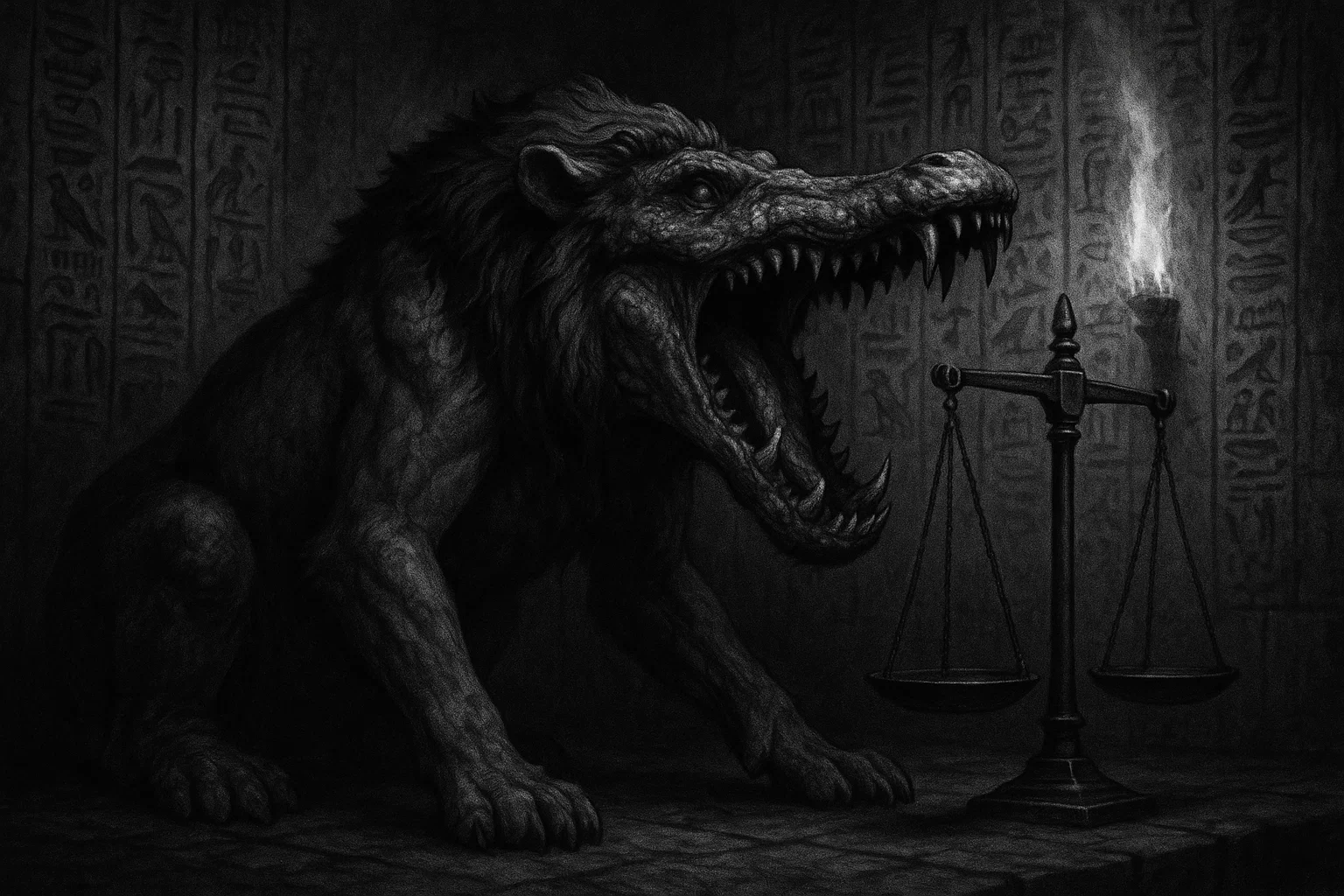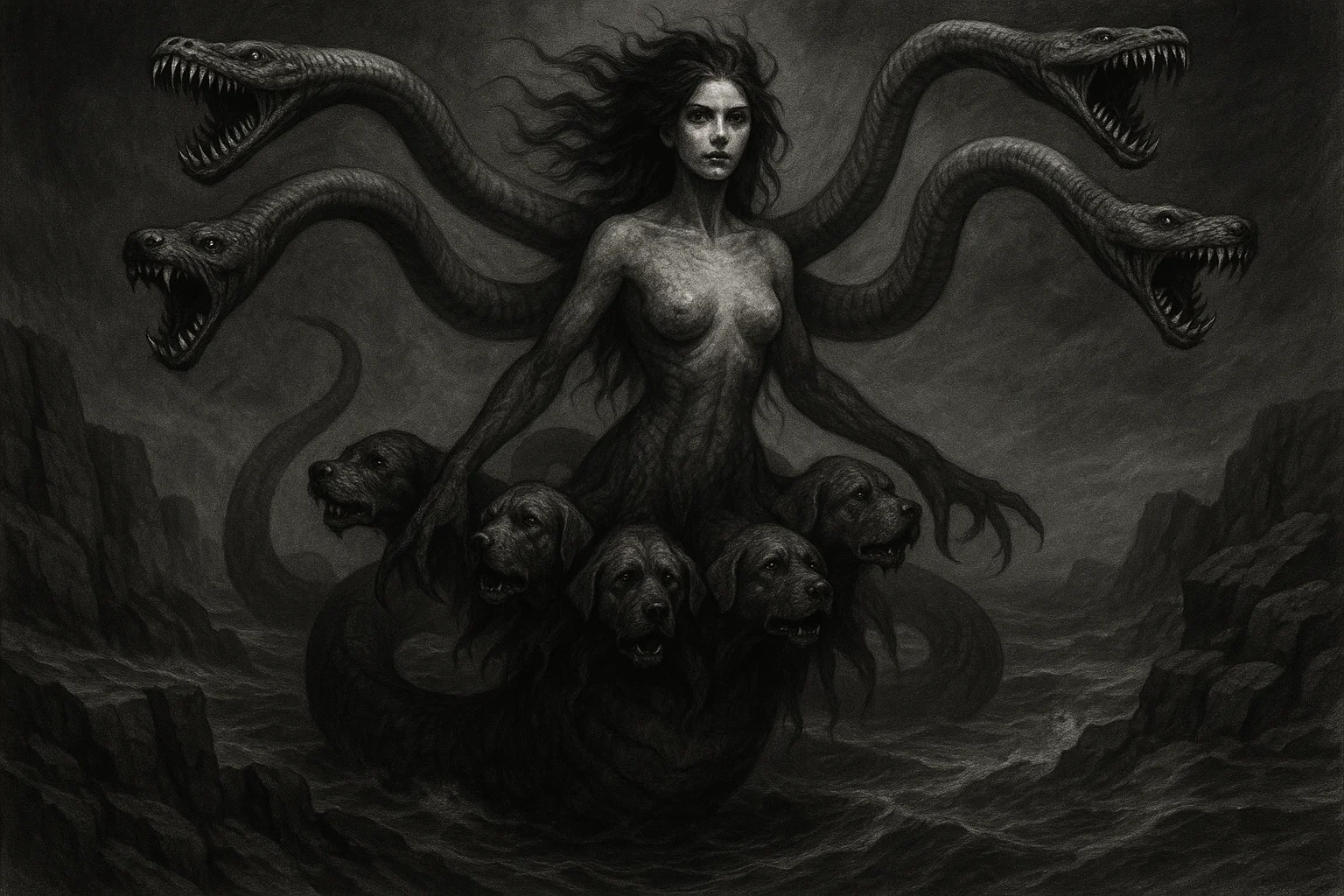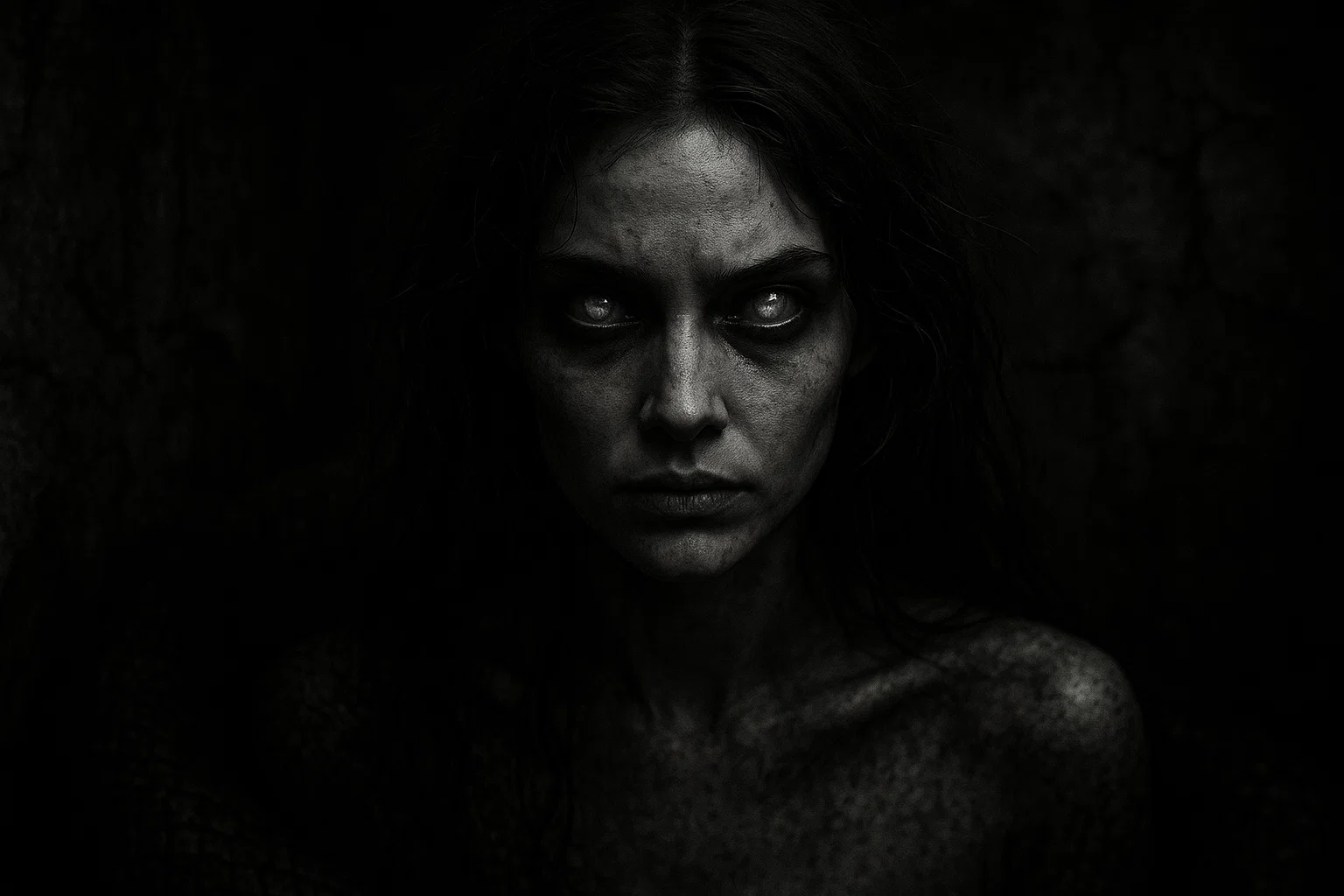In the treacherous depths of the Duat, where shadows claw at the edges of eternity and the weight of sin drags souls into abyss, Ammit emerges as the merciless enforcer of damnation.
This fearsome Egyptian demon, the eater of hearts, embodies the unrelenting horror of moral failure, her form a grotesque testament to the Nile’s predatory fury. For those delving into Ammit mythology, her tale weaves terror through the ancient Egyptian afterlife, a stark warning that impurity invites utter eradication.
Ammit‘s legacy in Egyptian demonology captivates with its fusion of dread and inexorable fate, positioning her as the ultimate devourer in the judgment of the dead. As the soul eater, she lurks in the halls of judgment, ready to consume the unworthy and perpetuate cycles of fear among the living.
Summary
Key Information
| Category | Details |
|---|---|
| Name | Ammit, Ammut, Ahemait, Amemet, Amam |
| Title | Devourer of the Dead, Eater of Hearts, Bone Eater, Great of Death, Devourer of Millions, Swallower of the Unworthy |
| Gender | Female |
| Role | Malevolent guardian of the underworld; devourer of impure souls in the Judgment of the Dead; embodiment of divine retribution and chaos; instigator of eternal unrest |
| Hierarchy | Subordinate to major deities like Osiris and Anubis in the Duat; functions as a mid-tier demonic enforcer without a cult; bound to the judgment process yet wielding terror autonomously |
| Servitors | None explicitly documented; operates as a solitary predator, though shades of devoured souls may linger as chaotic echoes |
| Superior Demon | Osiris (overlord of the Duat and judge); Anubis (master of the scales); Thoth (chronicler who enables her actions) |
| Powers | Heart devouring for soul annihilation; inducing paralyzing fear; enforcing moral corruption through dread; manifesting as an inescapable force in the afterlife |
| Appearance | Chimeric beast: crocodile head for lethal bite, lion or leopard forequarters for savage strength, hippopotamus hindquarters for crushing mass; variations include dog-like body, mane, or nemes headdress |
| Etymology | Derived from Ancient Egyptian ꜥm-mwt: ꜥm (“to devour/swallow”) + mwt (“the dead”); signifies “devourer of the dead” with phonetic variations reflecting dynastic shifts |
| Associated Figures | Osiris (judgment overseer), Anubis (weigher of hearts), Thoth (recorder of fates), Ma’at (feather of truth as her counter), Khonsu (precursor devourer), Apep (fellow chaotic entity) |
| Weaknesses | Confined by the balance of Ma’at’s scales; powerless against pure hearts; reliant on the judgment’s verdict, unable to act preemptively |
| Opposing Angel/Saint | Ma’at (goddess of truth and order); protective forces like Isis (nurturer) or Nephthys (mourner) who shield the worthy |
| Equipment/Tools | Jaws as primary weapon; proximity to the scales of Ma’at; no artifacts, but linked to funerary amulets that ward her influence |
| Pantheon | Ancient Egyptian mythology, prominent from Middle to Ptolemaic periods; demonic entity in the underworld realm |
Etymology
The name Ammit roots deeply in the linguistic fabric of ancient Egyptian culture, capturing her essence as a voracious predator of the damned.
Derived from the hieroglyphic term ꜥm-mwt, it amalgamates ꜥm, the verb for “to devour” or “to swallow,” with mwt, referring to “the dead”—specifically those souls deemed unworthy of joining the akhu, the blessed spirits who embodied harmony with Ma’at, the cosmic principle of truth and balance.
This compound word not only describes her function but evokes the terror of complete obliteration, a linguistic spell that ancient scribes wielded to instill fear in the living.
Variations in spelling and pronunciation across eras add layers to Ammit‘s etymological profile. Rendered as Ammut, Ahemait, Amemet, or Amam in different texts, these phonetic adaptations reflect regional dialects and scribal conventions from the Middle Kingdom onward.
For instance, the addition of determinatives—hieroglyphs like the crocodile or devouring mouth—emphasized her destructive nature, transforming the name into a visual and auditory ward against moral lapse. In funerary papyri, such as those from the New Kingdom, her title expands to “eater of hearts,” tying ꜥm to the organ symbolizing conscience, thus linking etymology to the weighing of the heart ritual.
Scholars trace Ammit‘s nomenclature to broader Nile Valley motifs of consumption and renewal, where devouring beasts represented chaos subdued by order. The root ꜥm echoes in words for gluttony or engulfment, while mwt connects to Mut, the mother goddess, ironically inverting nurturing into annihilation.
This duality highlights Egyptian demonology‘s complexity, where names held performative power—uttering Ammit could summon dread, reinforcing ethical behavior through linguistic dread. In Coffin Texts, precursors like Khonsu’s titles as “devourer of the red things” (hearts) foreshadow her name, suggesting an evolutionary etymology from lunar predation to dedicated soul-swallowing.
Further exploration reveals cross-cultural echoes in Ammit‘s name. Semitic languages feature similar roots for swallowing or destruction, hinting at trade-influenced exchanges along the Mediterranean. Yet, her core etymology remains uniquely Egyptian, a phonetic embodiment of the afterlife’s perils.
Titles like “Devourer of Millions” amplify her scale, implying an endless hunger for the masses of sinners, while “Bone Eater” extends devouring to skeletal remnants, symbolizing total erasure. Thus, Ammit‘s etymology serves as a gateway to understanding her as the antithesis of eternal life, a name that devours hope itself.
You May Also Like: Utukku: The Faceless Shadow Demon of Mesopotamia
What Does the Demon Ammit Look Like?
Ammit‘s visage is a nightmarish amalgamation crafted from the Nile’s deadliest fauna, designed to evoke primal revulsion and inescapable doom. Her head, that of a ferocious crocodile, features an elongated snout lined with razor-sharp teeth, eyes slitted with predatory cunning, and scales glistening like the river’s murky depths, ready to snap shut on any faltering soul.
The forebody draws from the lioness or leopard, with muscular shoulders sheathed in tawny or spotted fur, paws armed with lethal claws that dig into the underworld’s soil, embodying raw, feline savagery. This section often includes a flowing mane in artistic renditions, blending masculine aggression with her female form, amplifying her as a gender-transcending terror.
Her rear quarters mimic the hippopotamus, bulky and armored with thick, grayish hide, short legs supporting immense weight, symbolizing the crushing inevitability of judgment. In some Third Intermediate Period depictions, such as on coffin lids, she appears with a hippopotamus head and dog’s body adorned with teats, or in Ptolemaic papyri with a crocodile head on a canine frame, showcasing stylistic evolution while preserving her chimeric horror.
Overall, Ammit‘s form—crocodile for ambush lethality, lion for predatory speed, hippo for brute force—renders her an abomination that defies nature, her presence in vignettes a visual curse upon the impure.
Historical and Mythological Background
Ammit‘s origins delve into the shadowy evolution of ancient Egyptian beliefs about death, morality, and the afterlife, emerging as a specialized demon from broader concepts of divine punishment.
Absent in the earliest Pyramid Texts of the Old Kingdom (c. 2686–2181 BCE), where gods like Osiris began to dominate funerary rites, her precursors appear in the First Intermediate Period and Middle Kingdom Coffin Texts (c. 2181–2055 BCE and c. 2055–1650 BCE).
Here, the moon god Khonsu acts as a heart-devourer, consuming impure organs to empower himself or enforce order, setting the stage for Ammit‘s dedicated role. By the New Kingdom (c. 1550–1070 BCE), she crystallizes as the Devourer of the Dead, her image proliferating in tombs, papyri, and coffins as a deterrent, reflecting societal emphasis on Ma’at amid political turmoil.
Connections to other Egyptian deities abound, positioning Ammit within a web of chaotic forces. She shares traits with Taweret, the hippopotamus goddess who protects childbirth but embodies river dangers; Sekhmet, the lioness wreaker of plagues; and Sobek, the crocodile god of fertility and violence.
These links suggest Ammit as a composite of suppressed destructive aspects, a demon born from the gods’ darker sides. Beyond Egypt, parallels exist worldwide: in Mesopotamian mythology, Lamashtu, a hybrid demoness preying on the vulnerable, mirrors Ammit‘s fearsome form and retributive hunger.
Greek Cerberus guards Hades, preventing escape much like Ammit bars paradise, though without moral judgment. In Hindu lore, Yama’s hellhounds devour sinners, echoing heart-eating motifs, while Aztec Xolotl, a dog-headed guide to the dead, shares underworld guardianship. Norse Garmr, the blood-stained watchdog of Hel, parallels her as a chained beast of doom, and Babylonian Nergal’s underworld plagues align with her annihilative role.
These global ties underscore Ammit as part of a universal archetype—the devourer enforcing cosmic boundaries.
You May Also Like: Who Is Hanbi? The Formless Demon of Ancient Mesopotamia
The Weighing of the Heart Ceremony
The core legend featuring Ammit is the Weighing of the Heart, vividly detailed in Chapter 125 of the Book of the Dead, a compendium of spells from the New Kingdom. In the Hall of Two Truths within the Duat, the deceased arrives, often an elite like the scribe Ani (c. 1250 BCE), escorted by Anubis.
Osiris, enthroned with Isis and Nephthys flanking him, presides as judge, while Thoth, ibis-headed, prepares his reed pen and palette to record the outcome. The heart, extracted as the seat of deeds and conscience (Ib), is placed on one pan of the golden scales by Anubis, opposite Ma’at’s ostrich feather symbolizing unblemished truth.
The soul recites the Declaration of Innocence before 42 assessor gods, denying sins ranging from murder and theft to lying and causing hunger, each tied to specific deities like He Who Lives on Snakes for deceit. If the heart balances or proves lighter, the deceased is declared maa-kheru (“true of voice”) and advances to Aaru’s reed fields, eternal paradise of abundance.
But if weighted by transgressions, the scales tip, and Anubis flings the heart to Ammit, crouched eagerly below. Her jaws crush it in a spray of ethereal blood, devouring the essence and inflicting the “second death”—soul erasure, condemning the remnant shade to wander Duat’s horrors, prey to other demons or eternal thirst.
This ceremony, inscribed on personalized papyri buried with mummies, influenced daily life: pharaohs like Tutankhamun (c. 1332–1323 BCE) included protective spells in their tombs to evade Ammit.
Regional variations, such as Ra replacing Osiris in some Theban texts, highlight adaptability, yet Ammit‘s role remains constant—a malevolent force delighting in corruption’s downfall, her presence a psychological scourge promoting feigned virtue or outright despair.
Precursors and Evolving Legends
Before Ammit‘s ascendancy, Coffin Texts Spells 310 and 311 (Middle Kingdom) depict Khonsu as the heart-eater, declaring, “I am he who lives on hearts… He who devours the red things… I eat their hearts,” to gain power from impure or divine organs.
This lunar devouring, tied to moon phases symbolizing renewal through destruction, transitioned to Ammit in the New Kingdom, specializing her as a non-divine demon. Legends evolve: in some Twenty-first Dynasty coffins, Ammit guards gates of Duat, devouring intruders, expanding her from scales-side lurker to broader underworld terror.
Another strand portrays Ammit near the Lake of Fire (Book of the Dead Chapter 126), where impure souls not devoured are hurled into flames, her jaws snapping at escapees. This fiery motif, echoing Sekhmet’s plagues, shows Ammit as chaos’s agent, her hunger fueling the lake’s inferno.
In Ptolemaic adaptations, she appears in temple reliefs as “Bone Eater,” crunching skeletal remains of the damned, symbolizing total annihilation beyond flesh. These evolutions reflect cultural shifts: amid invasions, Ammit‘s legends intensified, her form warding tombs like those in the Valley of the Kings, ensuring only the prepared faced her without quaking.
You May Also Like: Namtar: The Demon of of Death and Disease
Ammit as the Embodiment of Chaos
In broader mythological narratives, Ammit personifies the chaos opposing Ma’at‘s order, akin to Apep’s daily battles against Ra. Legends whisper of her birth from primordial waters, a spawn of Nun’s abyss, tasked to consume excess impurity and maintain balance—yet her glee in devouring marks her as inherently malevolent.
Connections to Apep, the chaos serpent, suggest alliances in undermining creation, while her ties to Am-Heh, another “devourer of millions” in fiery lakes, position her in a demonic network.
Worldwide, this chaos role parallels Sumerian Ereshkigal’s underworld tyranny or Celtic Morrigan’s battlefield scavenging, where devourers cleanse through destruction, but Ammit‘s moral specificity sets her apart as judgment’s cruel edge.
Historical Mentions
| Text/Grimoire | Year | Description | Excerpt |
|---|---|---|---|
| Pyramid Texts (Unas Pyramid) | c. 2400–2300 BCE (Old Kingdom) | Early references to heart consumption by gods, precursor to Ammit’s role in judgment. | “The hearts of the gods are content… He has swallowed the knowledge of every god.” (Alluding to devouring for power.) |
| Coffin Texts (Spell 310) | c. 2055–1650 BCE (Middle Kingdom) | Khonsu as devourer of hearts, directly influencing Ammit’s function. | “I am Khonsu… I live on hearts, I devour the red things.” |
| Coffin Texts (Spell 311) | c. 2055–1650 BCE (Middle Kingdom) | Describes burning and devouring impure hearts, setting stage for Ammit. | “He who devours the hearts… Leaving the impure in Duat.” |
| Book of the Dead (Chapter 125, Papyrus of Ani) | c. 1250 BCE (Nineteenth Dynasty) | Ammit awaits to devour heavy hearts in the Hall of Two Truths. | “Ammit shall not be permitted to have power over him… The heart is not heavier than the feather.” |
| Book of the Dead (Chapter 79) | c. 1550–1070 BCE (New Kingdom) | Spells against heart devouring, invoking protection from Ammit-like forces. | “My heart shall not be eaten by any devourer… I have not committed sin.” |
| Book of the Dead (Papyrus of Nebqed) | c. 1391–1353 BCE (Eighteenth Dynasty) | Depicts Ammit without mane, emphasizing her role in judgment. | “The devourer crouches, but the justified pass.” |
| Coffin Lid of Ankh-hor | c. 943–716 BCE (Twenty-second Dynasty) | Shows Ammit as bone eater with variant form. | “Guard against the eater of bones who swallows the impure.” |
| Papyrus of Nes-min | c. 300–250 BCE (Ptolemaic Period) | Illustrates Ammit with dog body, near scales. | “The swallower awaits the fall of the heart.” |
You May Also Like: The White Lady of Hohenzollern: A Harbinger of Death and Disaster?
Ammit’s Powers and Abilities
Ammit possesses abilities honed for the annihilation of souls, distinguishing her from generic demons through her targeted, judgment-bound malevolence.
Her primary power, heart devouring, erases the essence of the unworthy, preventing rebirth and consigning remnants to Duat’s torments—a unique trait tied to Ma’at‘s scales, unlike broad possession or illusion common in other entities. This act corrupts by proxy: the dread of her hunger tempts mortals into hidden vices, as fear of exposure breeds deceit, ironically weighting hearts further.
Beyond consumption, Ammit induces paralyzing terror, her gaze piercing deceptions to reveal sins during judgment, accelerating corruption as the living spiral into paranoia.
In legends, she manifests shades from devoured souls, spectral harassers that tempt survivors into sin, perpetuating cycles of damnation. Her hybrid form grants invulnerability in Duat, regenerating from wounds, and death-force manipulation, siphoning vitality from the impure to fuel her existence.
Unlike common demonic temptations via whispers, Ammit corrupts through existential horror—her mere legend drives obsessive rituals or moral abandonment, turning virtue into vice’s mask.
Expanded abilities include enforcing unrest: post-devouring, souls become akh-less wanderers, their agony echoing to corrupt kin with guilt or superstition. In esoteric views, Ammit‘s presence warps time in judgment, replaying sins to amplify despair, a psychological torment unique to her role. This suite of powers positions her as Duat’s sadistic warden, her corruption subtle yet profound, luring humanity toward the scales’ fatal tilt.
| Power/Ability | Description | Source | How It Tempts/Corrupts Humans |
|---|---|---|---|
| Heart Devouring | Selective consumption of impure hearts, leading to second death and soul erasure. Unique: Moral-specific annihilation vs. random torment. | Book of the Dead, Ch. 125 | Fuels lifelong dread, tempting denial or overcompensation in deeds, corrupting authenticity into facade. |
| Terror Inducement | Projects paralyzing fear, revealing hidden sins. Common amplified: Pre-judgment anxiety escalates to breakdown. | Coffin Texts, Spells 310-311 | Paranoia breeds secret vices; mortals sin more to “balance” perceived wrongs, tipping scales. |
| Shade Manifestation | Creates restless ghosts from devoured, haunting the living. Unique: Propagates generational chaos. | New Kingdom papyri | Guilt-ridden survivors turn to dark rites for appeasement, eroding societal Ma’at. |
| Invulnerability | Regenerates in Duat, immune to assaults. Common: Demonic resilience, but tied to judgment’s sanctity. | Ptolemaic depictions | Tempts defiance of ethics, as perceived invincibility mirrors human hubris leading to fall. |
| Death-Force Siphoning | Drains vitality from impure, empowering herself. Unique: Feeds on moral decay. | Middle Kingdom texts | Corrupts by encouraging neglect of virtue, as “small sins” accumulate into fatal weight. |
How to Counter Ammit’s Powers
To thwart Ammit‘s devouring grasp requires unwavering adherence to Ma’at, fortifying the heart against her hunger through ritual and resolve. Ancient spells from the Book of the Dead, like Chapter 30, inscribed on heart scarabs of green jasper or faience, command the organ: “Do not testify against me… Remain light as the feather,” binding it to silence sins and evade her jaws.
Living countermeasures emphasize ethical deeds—truth-telling, justice, harmony—rendering her powerless, as pure hearts pass unmolested. Amulets depicting Ma’at or protective gods like Isis, worn or buried, create barriers, their enchantments repelling Ammit‘s terror. In judgment, invoking Thoth for accurate recording or Anubis for fair weighing disrupts her anticipation.
Modern Kemetic practices adapt these: meditations visualizing balanced scales, Nile-water purifications to cleanse “heavy” emotions, or affirmations denying the 42 sins. Ultimately, integrity disarms her—virtue’s armor against the soul eater‘s bite.
You May Also Like: Children Vanished: The Werewolf of Eschenbach Case
Ammit’s Role in the Hierarchy of Hell
Within the labyrinthine structure of the Duat—Egypt’s infernal realm akin to hell—Ammit holds a pivotal yet subordinate position as a demonic executor, enforcing verdicts under the authority of higher deities.
Osiris, as overlord of the underworld, commands the judgment process, with Ammit acting as his merciless tool, her devouring bound to the scales’ outcome. Anubis, the jackal-headed weigher, ranks above her, delivering hearts directly, while Thoth’s recordings enable her actions, placing her in a mid-tier echelon among netjeri (lesser divine forces).
She lacks servitors or legions, her solitude emphasizing focused terror, though devoured shades may serve as unwitting extensions of her chaos. Superior to minor imps haunting Duat’s fringes, Ammit is outranked by chaotic titans like Apep or Set, who disrupt cosmic order broadly.
Relationships are tense: allied with Am-Heh in fiery devouring, yet restrained by Ma’at’s principles, preventing unchecked rampage. In grimoires like the Book of the Dead, her rank underscores necessity— a demon essential for balance, yet reviled, her presence stabilizing the hierarchy through fear-induced obedience.
Expanded lore positions Ammit as Duat’s gatekeeper variant, her role evolving from Khonsu’s lunar predation to specialized enforcer, reflecting theological shifts. Among demons, she parallels Babi’s aggressive baboon fury but focuses on cardiac judgment, her mid-rank allowing autonomy in corruption while chained to divine will.
Astrological Associations and Symbolism
Ammit‘s symbolism encapsulates the Nile’s perilous duality—destruction veiled as renewal—infusing her with astrological ties that amplify her dread.
Though ancient texts lack direct zodiac links, occult interpretations associate her with Scorpio, the sign of transformation and hidden depths, where death precedes rebirth, mirroring her soul-erasing hunger. Her water element dominates, drawn from crocodile and hippo habitats, symbolizing emotional abysses and chaotic floods that test moral resolve.
Colors evoke her form: deep emerald green for crocodile scales’ stealthy menace, crimson red for bloodied hearts devoured, obsidian black for Duat’s void.
Numbers include 3 for her tri-hybrid body, signifying completeness in annihilation, and 42 for the sins she judges, a tally of human frailty. Metals like iron represent unyielding retribution, while copper ties to transformative fires she guards. Stones and crystals such as obsidian (sharp for soul-cutting), hematite (grounding heavy sins), and malachite (Nile protection, ironically countering her) enhance her essence.
Zodiac extensions link her to Libra’s inverted scales, where justice turns punitive, or Capricorn’s stern discipline. Symbolically, she embodies chaos tamed, her form a talisman against impurity, though feared. These associations deepen Ammit as a harbinger of fateful reckonings.
| Association | Details |
|---|---|
| Element | Water (Nile’s chaotic depths, emotional judgment) |
| Number | 3 (chimeric parts); 42 (assessed sins) |
| Metal | Iron (implacable strength); Copper (fiery transformation) |
| Stone/Crystal | Obsidian (devouring edge); Hematite (sin-weight anchor); Malachite (ironic ward) |
| Color | Emerald green (crocodile stealth); Crimson red (heart blood); Obsidian black (void) |
| Zodiac | Scorpio (soul death/rebirth); Libra (punitive scales) |
You May Also Like: Rokurokubi Legends: Women Who Transformed Into Night Demons
Ammit’s Sigil
Unlike summoned demons with codified sigils, Ammit possesses no ancient emblem for invocation, her taboo nature precluding rituals. Modern occultists construct sigils fusing her hybrid: a crocodile jaw encircling lion claws and hippo haunches, inscribed with ꜥm-mwt hieroglyphs, charged for banishing corruption rather than calling her forth.
In Kemetic revivalism, this glyph adorns altars during solstice rites, symbolizing judgment’s threshold. Expanded uses include shadow work, where meditating on the sigil “devours” personal flaws, fostering growth amid terror.
| Symbol/Item | Association/Meaning | Use in Rituals |
|---|---|---|
| Crocodile Scale | Lethal ambush; hidden dangers | Warding meditations against deceit |
| Lion Mane | Savage dominance; untamed fury | Strength invocations for resolve |
| Hippo Hide | Crushing inevitability; watery chaos | Grounding rites to face fears |
| Owl Hieroglyph | Death association; eater of souls | Funerary simulations for preparation |
| Scales Icon | Judgment’s balance; Ma’at’s counter | Equilibrium spells to lighten heart |
Comparison with Other Demons
| Demon/Entity | Origin/Pantheon | Role & Powers | Comparison to Ammit |
|---|---|---|---|
| Am-Heh | Egyptian | Devourer of millions in fiery lakes; soul incineration | Similar fiery annihilation; differs in lake focus vs. scales, male form. |
| Sekhmet | Egyptian | Plague-bringer, vengeful destroyer; disease infliction | Shared lioness ferocity; contrasts as worshipped goddess with healing aspect. |
| Babi | Egyptian | Aggressive afterlife punisher; heart-rending rage | Parallel baboon aggression; less judgment-specific, emphasizes virility. |
| Khonsu | Egyptian | Lunar heart-eater precursor; cycle manipulation | Evolved from his role; adds benevolence as healer god. |
| Taweret | Egyptian | Hippo guardian against evil; protection in childbirth | Hybrid elements; opposite as maternal protector vs. destroyer. |
| Apep | Egyptian | Chaos serpent; solar disruption | Allied in disorder; broader cosmic threat without moral judgment. |
| Cerberus | Greek | Underworld gatekeeper; multi-headed prevention of escape | Guardian parallel; lacks devouring based on ethics. |
| Lamashtu | Mesopotamian | Hybrid demoness preying on vulnerable; infant soul-snatching | Form and predation similarity; targets living vs. dead. |
| Garmr | Norse | Hellhound of Hel; blood-stained doom-bringer | Watchdog role; tied to Ragnarok apocalypse vs. individual judgment. |
| Xolotl | Aztec | Dog-headed guide to dead; lightning manipulation | Underworld escort; includes creative aspects absent in Ammit. |
You May Also Like: El Silbón: Why Locals Say Its Whistle Means Death Is Near
Conclusion
Ammit, the relentless Devourer of Souls, etches a chilling silhouette across ancient Egyptian mythology, her chimeric form a perpetual emblem of damnation’s jaws.
From etymological roots in devouring to her pivotal role in the weighing of the heart, she embodies the terror of moral reckoning, connections to global devourers underscoring her archetypal dread. Expanded powers and hierarchical ties reveal a demon whose corruption seeps through fear, shaping ethics into a battlefield of shadows.
Yet, in her malevolence lies a twisted mirror to humanity’s flaws, her hunger a catalyst for reflection amid horror. As the eater of hearts in the Duat, Ammit devours not merely flesh but illusions of impunity, her legacy a grim beacon in Egyptian demonology.
Ultimately, confronting Ammit demands purity’s forge, her presence a eternal admonition that vice invites oblivion’s embrace. In the annals of myth, she endures as chaos’s fang, biting through the veil of pretense.







